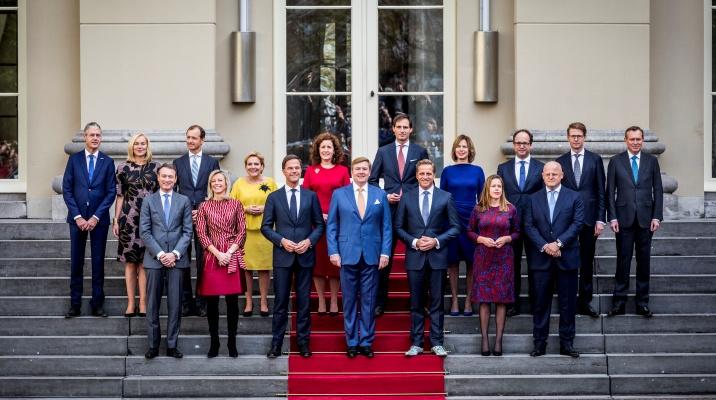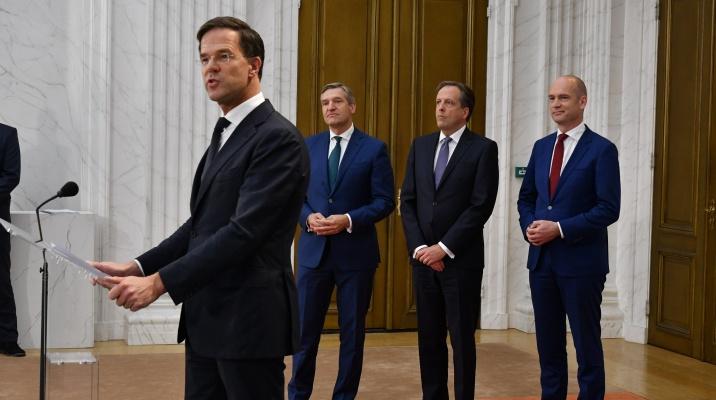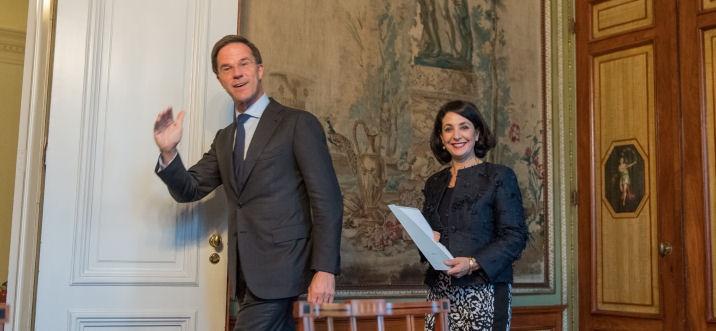Rutte III cabinet sworn in at Noordeinde Palace
On Thursday morning 26 October 2017, the Rutte III cabinet was sworn in by King Willem Alexander at Noordeinde Palace in The Hague, followed by the traditional photograph on the steps of the palace. The taking office of the new cabinet also causes changes in the composition of the House of Representatives. On Tuesday 31 October, twelve new MPs will be sworn in: six VVD, three D66, two CDA and one ChristianUnion MPs. The debate about the Government Statement will be held on Wednesday 1 and Thursday 2 November.
Final report formateur and division of policy areas among ministers and state secretaries

On Wednesday 25 October, cabinet formateur Mark Rutte submitted his final report to the President of the House of Representatives, Ms Khadija Arib, in the Stadholders's Room in the building of the House of Representatives. On Wednesday afternoon, the candidate ministers of the new Cabinet met for the first time at the Prime Minister's department, the Ministry of General Affairs. During this so-called "constituent assembly" the portfolios or policy areas of the ministers and state secretaries were formalised. On Friday 27 October, the first Council of Ministers will take place in its new composition.
Meet the members of the Rutte III cabinet
Twelve new MPs
The taking office of the new cabinet also causes changes in the composition of the House of Representatives. Tuesday 31 October will see the swearing in of twelve new MPs:
- Antoinette Laan-Geselschap (VVD)
- Judith Tielen (VVD)
- Hayke Veldman (VVD)
- Rudmer Heerema (VVD)
- Wybren van Haga (VVD)
- Leendert de Lange (VVD)
- Evert Jan Slootweg (CDA)
- Lenny Geluk-Poortvliet (CDA)
- Monica den Boer (D66)
- Matthijs Sienot (D66)
- Joost Sneller (D66)
- Stieneke van der Graaf (ChristenUnie)
Consultations with designated cabinet members
On Monday 23 and Tuesday 24 October, formateur Mark Rutte had separate consultations with the designated members of the new cabinet of VVD, CDA, D66 and ChristianUnion. On Friday 20 October, it was announced that the cabinet will comprise a total of 24 members: sixteen ministers, inclucing the Prime Minister and four ministers without portfolio, and eight state secretaries. On Saturday 21 October, formateur Rutte had talks with the three designated deputy Prime Ministers Kajsa Ollongren (D66), Hugo de Jonge (CDA) and Carola Schouten (ChristianUnion).
Cabinet consisting of VVD, CDA, D66 and ChristianUnion
On 12 October 2017, the House of Representatives appointed Mark Rutte as formateur in a debate about the final report of informateur Gerrit Zalm, which the latter had presented to the President of the House of Representatives, Ms Khadija Arib, on 10 October 2017. Rutte was given the assignment to form a cabinet consisting of VVD, CDA, D66 and ChristianUnion. On 10 October, these four parties presented their Coalition Agreement entitled 'Confidence in the Future'.
Coalition Agreement 'Confidence in the Future'

Read the Coalition Agreement 'Confidence in the Future'
Longest formation process in Dutch parliamentary history

The cabinet formation process following the general elections of 15 March 2017 was the longest ever in Dutch parliamentary history. The President of the House of Representatives, Ms Khadija Arib, is glad that there is a Coalition Agreement at last and that a new cabinet will take office shortly. "The House can now resume its work at full speed - a moment long awaited by the members of the House of Representatives. It is about time for the House to take up its key tasks again, i.e. to monitor and oversee the cabinet's work and to act as co-legislator".
According to informateur Zalm, the long duration of the cabinet formation process is due to the fragmentation of the political landscape after the elections, as a result of which at least four parties were now required to form a majority coalition. "The negotiations involved four parties, each having different standpoints and backgrounds. That is more complex than negotiations between two parties. And it takes more time. Nevertheless, throughout the long formation process, the parties involved displayed perseverance and a sense of responsibility." The informateur said he deeply regrets that parts of the Coalition Agreement leaked out to the media, epecially as the finish came in sight.
VVD, CDA, D66 and Christion Union in agreement on the Coalition Agreement
On Monday, 9 October 2017, VVD, CDA, D66 and ChristianUnion said yes to the draft Coalition Agreement, following consultations and some fine-tuning. Eventually, the negotiators adopted the final Coalition Agreement on Tuesday, 10 October.
Assignment
Mr Gerrit Zalm had been appointed informateur on Wednesday, 28 June 2017. His assignment was to explore the possibilities of forming a cabinet consisting of the People's Party for Freedom and Democracy (VVD), the Christian Democratic Appeal (CDA), Democrats 66 (D66) and the ChristianUnion (ChristianUnion), which cabinet was to strive for broad-based political support in parliament.